Yesterday morning this curlew gave me a lesson on what “opportunistic foraging” really means.
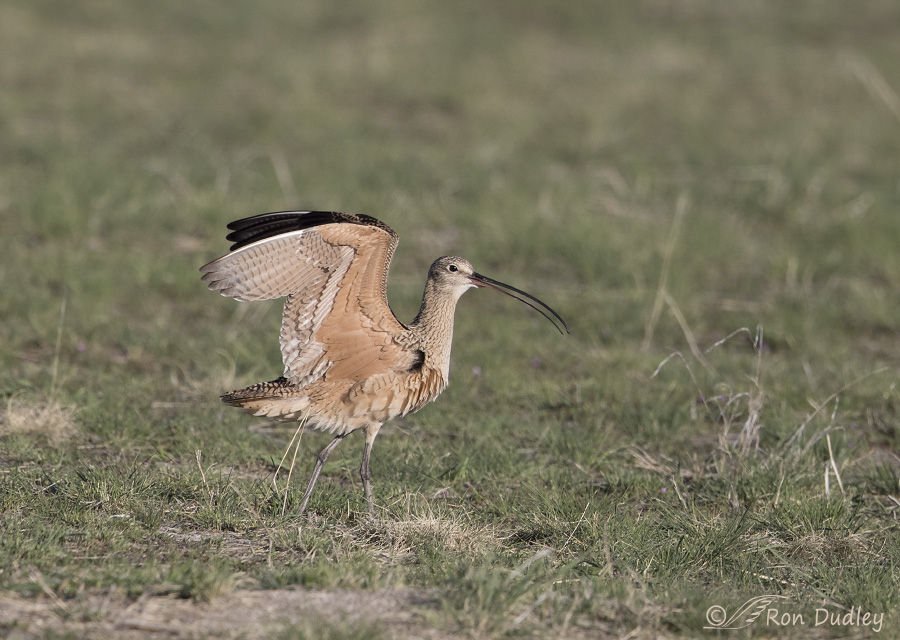
1/2500, f/6.3, ISO 500, Canon 7D Mark II, Canon EF 500mm f/4L IS II USM + 1.4 tc, not baited, set up or called in
I spent much of the morning photographing Long-billed Curlews on Antelope Island. They would occasionally display to other curlews…
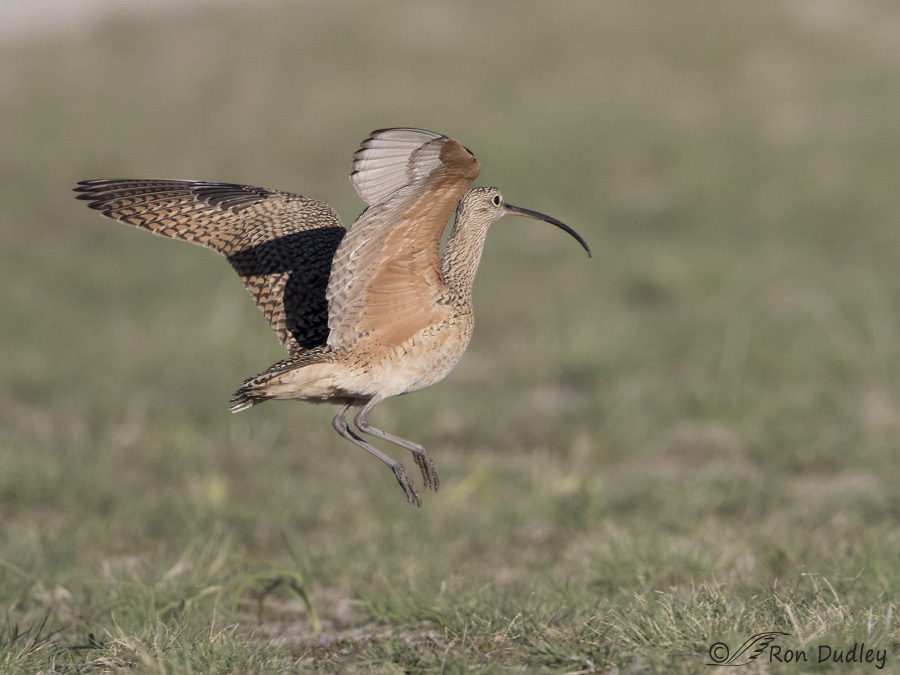
1/3200, f/6.3, ISO 500, Canon 7D Mark II, Canon EF 500mm f/4L IS II USM + 1.4 tc, not baited, set up or called in
or jump in the air and act just a little bit goofy.
But they spent most of their time foraging for food. On their breeding grounds the diet of this species consists primarily of insects and over the years that’s about all I’ve ever seen them eat when I could identify the food item. But they’re often described as being “opportunistic feeders” and one of these curlews demonstrated that fact for me when it apparently encountered a Horned Lark nest hidden in the grass.
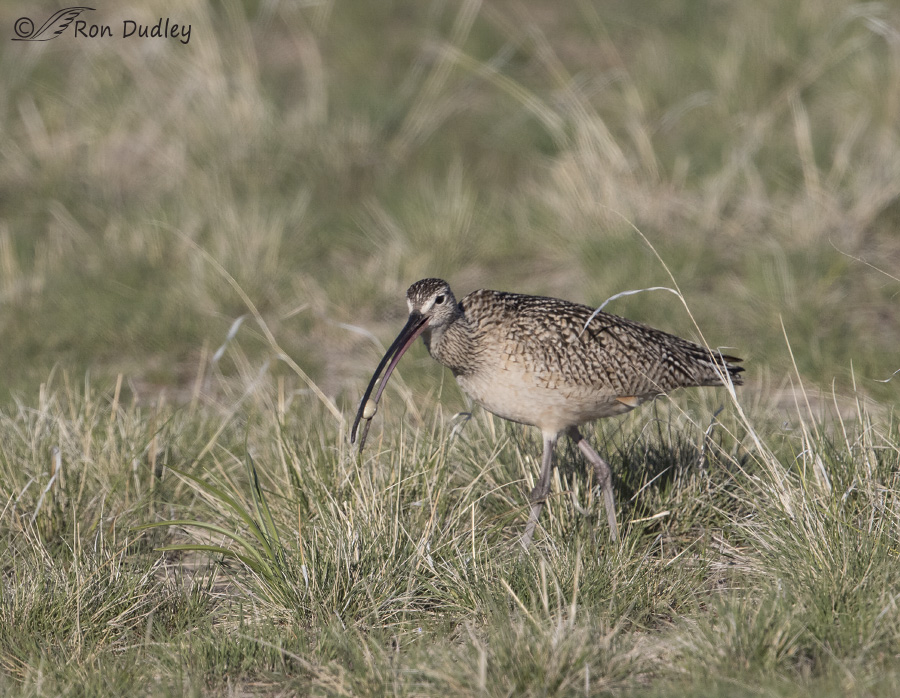
1/3200, f/6.3, ISO 500, Canon 7D Mark II, Canon EF 500mm f/4L IS II USM + 1.4 tc, not baited, set up or called in
I was mostly just watching this bird through my lens (it wasn’t very close and it usually had grass in front of it so I wasn’t pressing my shutter button) when it suddenly picked something up from behind the clump of grass in front of it. At the time I didn’t know what it was but I fired off a burst to see if I could identify it later. It turned out to be a small bird’s egg.
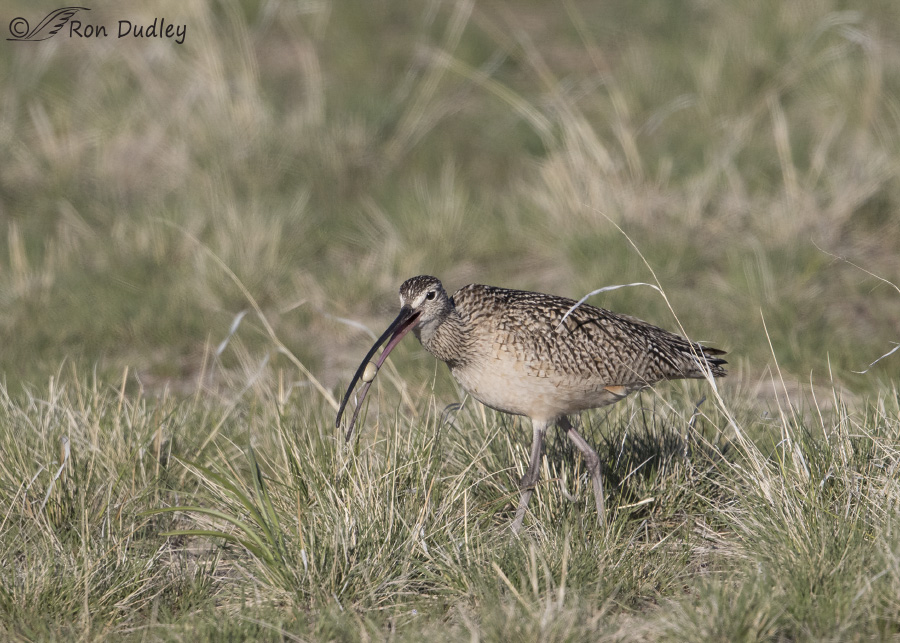
1/3200, f/6.3, ISO 500, Canon 7D Mark II, Canon EF 500mm f/4L IS II USM + 1.4 tc, not baited, set up or called in
It quickly moved the egg up its very long bill in preparation for swallowing.
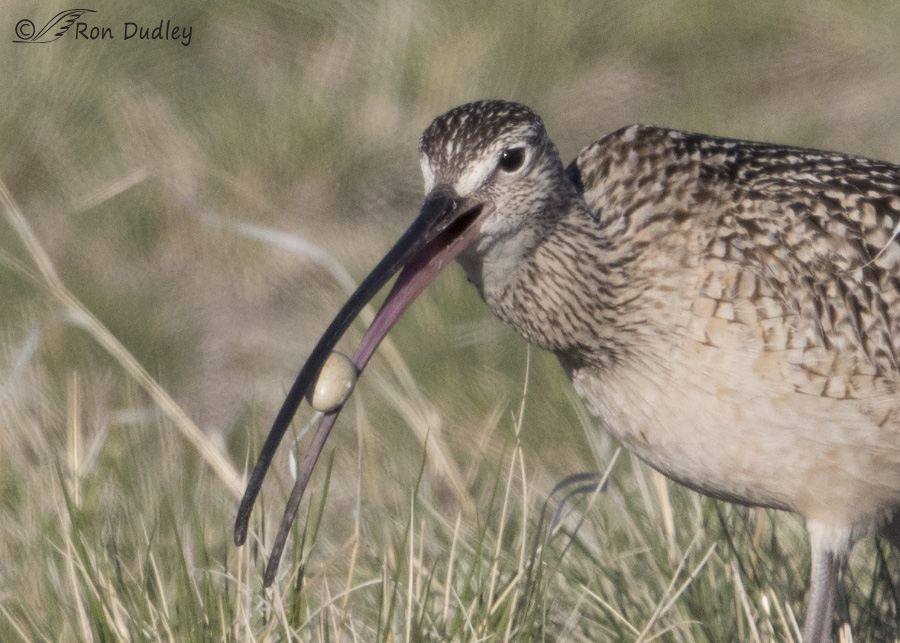
A very large crop of the previous image confirms that it really is a small, lightly speckled egg.
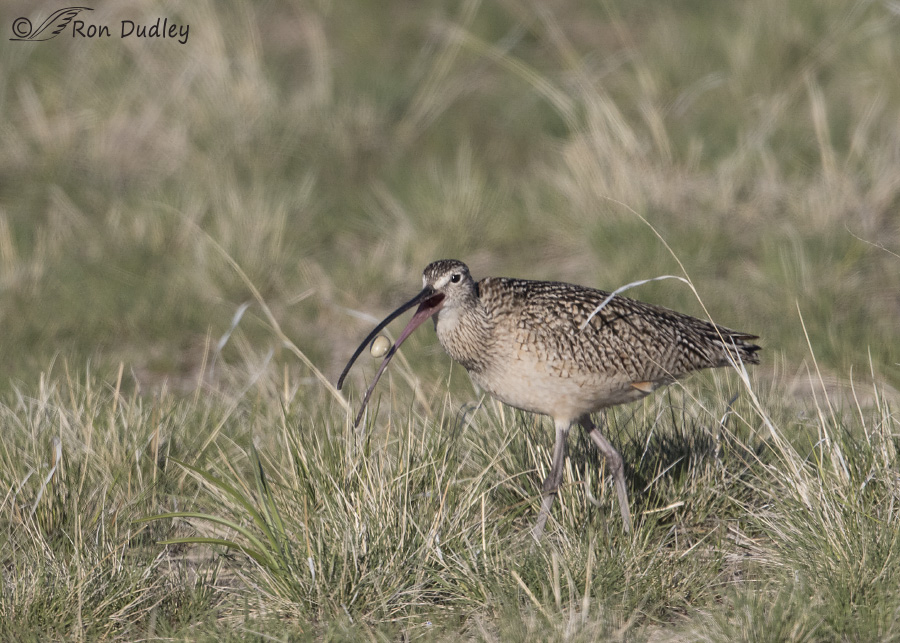
1/3200, f/6.3, ISO 500, Canon 7D Mark II, Canon EF 500mm f/4L IS II USM + 1.4 tc, not baited, set up or called in
In one shot, not quite as sharp as the others, I caught the egg in midair (the bill is not touching the egg).
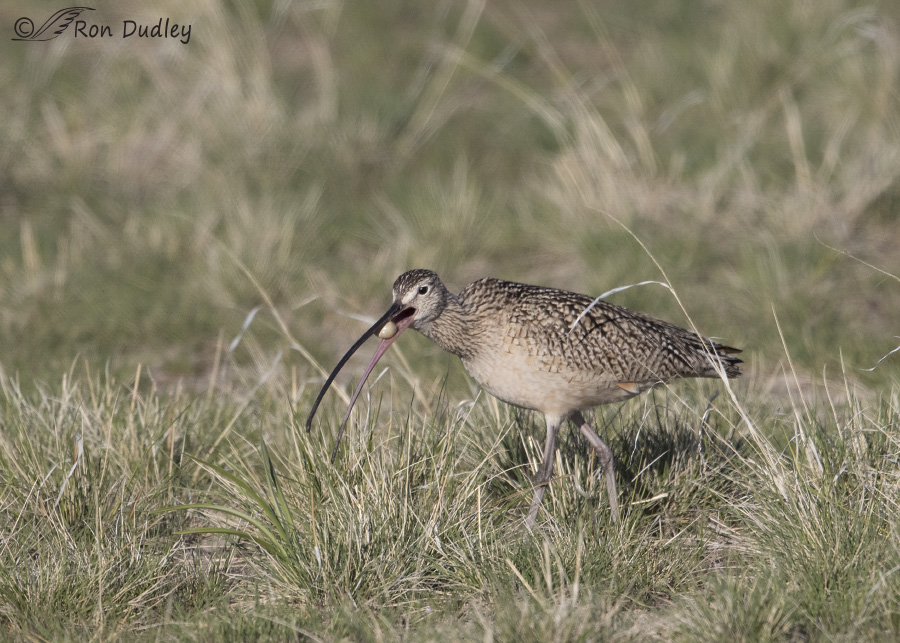
1/3200, f/6.3, ISO 500, Canon 7D Mark II, Canon EF 500mm f/4L IS II USM + 1.4 tc, not baited, set up or called in
The egg had to travel a good distance up that long bill but it’s almost there.
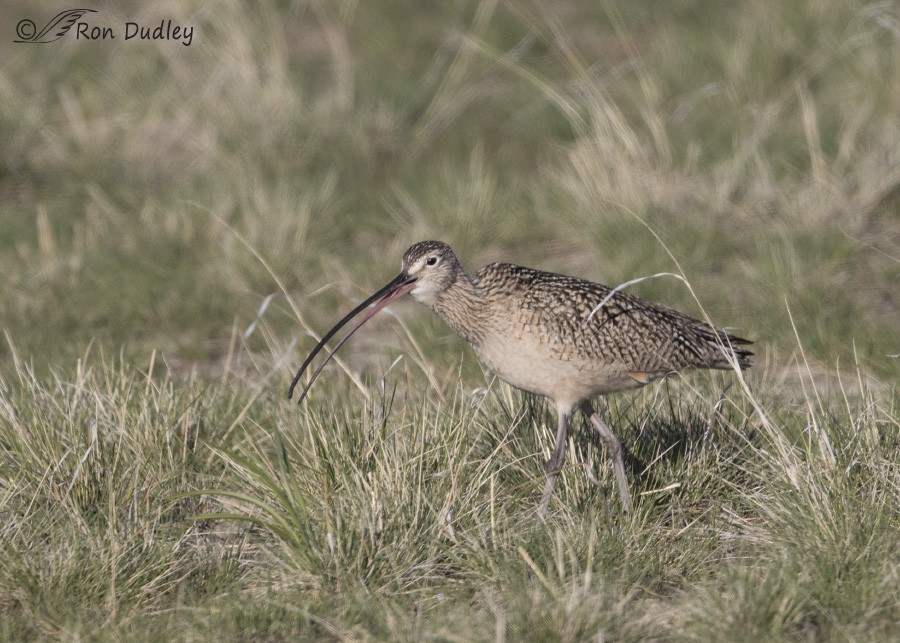
1/3200, f/6.3, ISO 500, Canon 7D Mark II, Canon EF 500mm f/4L IS II USM + 1.4 tc, not baited, set up or called in
Down the hatch (I enjoy the irony of that phrase in this situation…).
This behavior surprised me for two reasons:
- I had never before observed curlews raiding bird nests and to be honest I’d never even considered the possibility
- The curlew swallowed the egg whole instead of breaking it and eating its contents. This makes me wonder how the egg is broken internally since I assume the shell would be impervious to digestive enzymes (perhaps stomach acids weaken the shell?) and it seems to me that peristalsis would apply pressure to the shell fairly evenly and make it difficult to break (I suspect many of us know how difficult it is to break a chicken egg by enclosing our fist around it and squeezing hard…).
I little research suggests that I shouldn’t have been surprised that curlews eat the eggs of other birds. I found the following about Long-billed Curlews on Birds of North America Online:
- “On breeding grounds, appears to be opportunistic forager, supplementing a diet of invertebrates such as grasshoppers and beetles (Coleoptera) with small vertebrates like bird eggs and nestlings”.
- Found nests of ground-nesting Horned Lark (Eremophila alpestris) by walking immediately to spot where bird flushed, ignoring distraction displays and repeated strikes on the back and neck by the adult Horned Lark. Harassed by McCown’s Longspur (Calcarius mccownii) and Horned Lark, suggesting depredation of these species’ nests may be common”.
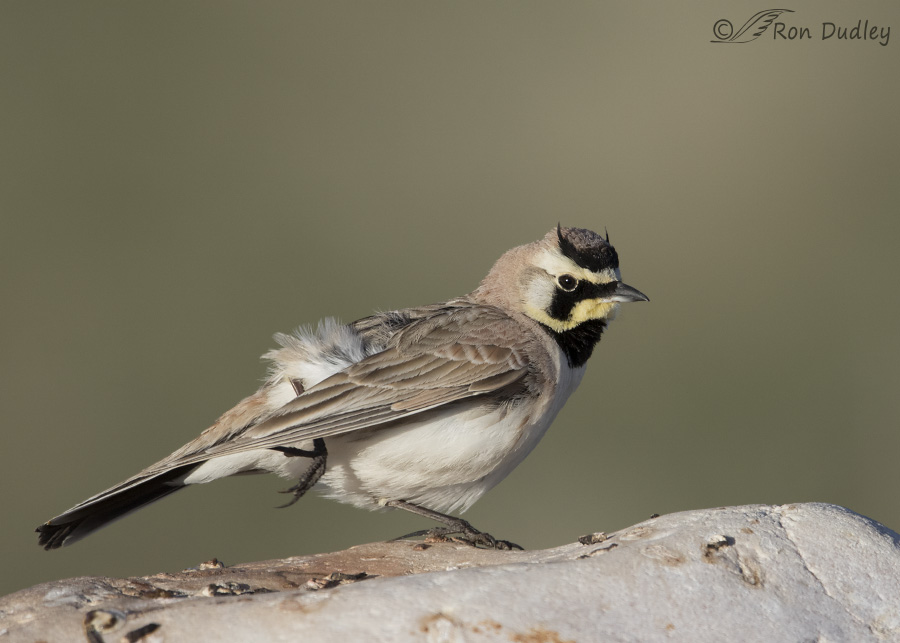
1/4000, f/6.3, ISO 640, Canon 7D Mark II, Canon EF 500mm f/4L IS II USM + 1.4 tc, not baited, set up or called in
For a variety of reasons I’m quite confident (though not positive) that the egg belonged to a Horned Lark.
- Horned Larks are extremely common in the immediate area where I was photographing the curlews – this image of a male was taken in the same area within a few minutes of when the curlew swallowed the egg.
- It’s nesting season for Horned Larks and they’re ground nesters.
- The egg size and color matches the description of Horned Lark eggs.
- I suppose it’s possible that the egg belonged to Western Meadowlarks (they’re also common in the area) but to my untrained eye it looked too small to belong to that species.
I’ve never thought of curlews as being nest-raiders and the thought of them eating nestlings of other species is a new one for me. I don’t have any problem with it though – it is what it is.
Ron


Assumptions are dangerous things aren’t they? We all make them. Often without realising.
There are just so many threats to the ground nesters. It is a wonder that they survive. I am wondering whether the ground nesters are more prone to multiple broods a season?
Interesting question, EC. I don’t know…
What an amazing series Ron! Sensational!
Charlotte
Thanks very much, Charlotte.
Wouldn’t the stomach acid HCL react with the alkaline shell and dissolve it?
Bobbi, yes, I believe the HCL reacts with the calcium carbonate in the shell. The standard geological field test for limestone (which is also made of calcium carbonate) is to add a few drops of weak HCL to the sample. If it reacts with the rock by bubbling, the sample is limestone.
All things considered, it’s amazing that any ground-nesting birds survive at all. It’s one thing when you’ve got an uber-Mom redtail (raptor) in charge at the nest, but quite another when you don’t. I wonder what behaviors are involved with the parent(s) of that egg? And why that egg was available for eating? Then, there’s the issue of how the egg(shell) was digested. Oh the questions…
And again, the standard Oh WOW! applies here.
“All things considered, it’s amazing that any ground-nesting birds survive at all”
It sure is, Laura. I suspect that nest camouflage is the key but like most strategies it isn’t always successful.
While bird books indispensable, I find your “picture story” a lot more interesting and informative. The photos of the behavior help me remember. At my age, I need all the help I can get. 🙂 Thanks, Ron!!
“At my age, I need all the help I can get”
I know how you feel, Jane!
Patty, I think only those birds related to chickens and ducks have gizzards. After snakes eat eggs and crush them they regurgitate the egg shells, but I doubt birds do that.
I don’t know if curlews have gizzards or not – some birds don’t.
It may be that the stomach acid (HCL – hydrochloric acid) dissolves the shell. The shell is largely calcium carbonate and if I remember my college geology correctly HCL dissolves calcium carbonate.
I looked it up and found several sites that said, “The HCL in the stomach rapidly dissoves the calcium carbonate of the shell” ..(.the question I asked was, “can eggshell be digested.”)
Now you’ve really got me curious about the bird’s internal breakdown of that eggshell…gizzard???
That’s what I thought…just wondered if MAYBE curlews had them…otherwise, hiw the heck DO they handle the shells??? Our chickens loved the occassional egg shells, also oyster “grit” but thry did have gizzards to grinfps them up…stomach acids must have completed the process….
“stomach acids must have completed the process”
That’s my guess, Patty, but I don’t know for sure.
Amazing photos Ron. From start to finish how long did it take to get that egg down the hatch? I had never thought about it before, but all long billed birds must us the same technique for getting food from their bill tip to their mouths, thus all of the insects must be killed or mortally wounded before attempting this maneuver or some might escape during the process.
“From start to finish how long did it take to get that egg down the hatch?”
Marvin, it was very quick – perhaps half of a second. That estimate is based on the fact that I was shooting a burst, my camera shoots 10 frames per second in a burst and there were five shots from the first one with the egg until the shot where it had been swallowed.
It’s possible I may have paused for an instant during the burst but I don’t remember doing so.
Great series and education, Ron! Funny how we have in our minds certain things about certain creatures and are surprised by them 🙂
Yep, that’s exactly what I did, Judy – made an unconscious assumption that curlews weren’t nest raiders. Assumptions can be dangerous…
There is nothing like first hand on the spot record pictures of species behavior! We can read a ton of stuff on what a bird does, but a picture, as the saying goes, “is worth a 1000 words!”
Absolutely great shots and a wonderful lesson. It is a tough world out there – survive or die! Our feeling function would be suppressed if we needed to make choices to survive.
Thank you, Dick.